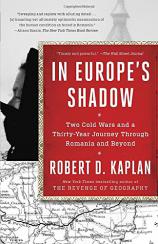In Europe's Shadow: Two Cold Wars and a Thirty-Year Journey Through Romania and Beyond
Review
In Europe's Shadow: Two Cold Wars and a Thirty-Year Journey Through Romania and Beyond
Robert D. Kaplan is uniquely suited to write about the history (especially during the last 30-plus years) of the country of Romania. Approaching the end of his service with the Israel Defense Forces in 1981, he had little idea of his next plan, position or career path. During his time in Israel, he had become fascinated with places of worship, whether they were Jewish, Christian or Muslim; while he had written about them for a number of publications, his writing income was minimal. One hot day in Jerusalem, he picked up a used book that would determine the course of his life and work in significant ways.
The book was THE GOVERNMENTS OF COMMUNIST EAST EUROPE by H. Gordon Skilling. As Kaplan read through the Cold War expert’s treatise, he realized that, unlike Israel and the Middle East, Eastern Europe was a place that few journalists were writing about. His own experiences in the early 1970s as a tourist in Romania, Poland, Hungary and other Eastern European nations had made a significant impression on him. According to Skilling, the current policies and politics of these countries were the result of over a thousand years worth of history, wars, ethnic divisions and, perhaps most basic of all, geography. Certainly the area must afford a rich supply of news and stories. And so, the day after Kaplan was released from the IDF, he purchased a ticket for Bucharest. His new life as a foreign correspondent in Eastern Europe, specifically Romania, began.
"Kaplan is an excellent historical recounter. He is at his finest when describing, in the richest of detail, the resurrection of Romanian culture."
Romanian architecture and art critic Sherban Cantacuzino observed this: “National traits are determined by race, climate and topography. Frequent raids and invasions have made Romanians tough, brave and resilient. Political instability, the uncertainty of what the future holds, has made them intensely resourceful and practical…” Kaplan introduces the reader to Romania not only via his own experiences over the course of 33 years of travel, writing and research, but also through the observations, via his own senses, of Romania’s beauties and catastrophes. And what does the American/Western reader learn about this country, when many of us are more familiar with the Cold War history of the Soviet Union and East Germany?
Kaplan reveals the devastation of Nicolae Ceausescu’s “Romanian Communist” (as differentiated from Russian Communist) rule, as well as that of World War II leader Mihai Antonescu, who partnered with Hitler and oversaw the slaughter of Jews in some outlying Romanian regions, even as he saved many in Romania proper. We meet Romanian intellectuals, poets and professors. We see the effects of Romanian Communism as it sought to homogenize the culture and even eradicated it in many ways. Kaplan discusses how Romania was at the mercy of its own geography as Roman, Greek, Turkish and Russian conquerors moved across the area through the centuries.
The book also shows us how dramatically Romania has changed over the years as Communism made way for a more democratic society, and how the ugliness and grayness of Ceausescu’s era have been replaced by a more Western appearance. Yet it’s not only Westernizing influences that are changing Romania; it’s a restoration of the nation’s beauty (whether in its Byzantine and Gothic architecture, or the richness of the forests and countryside) that’s visible to the traveler or resident of the city, village or rural areas.
Kaplan is an excellent historical recounter. He is at his finest when describing, in the richest of detail, the resurrection of Romanian culture. Whether it’s the colors on a church’s hand-painted murals or the trees surrounding an area, his descriptions are vivid and almost palpable. His observations of the Romanian people and culture are equally as arresting, especially as he shares his interviews with politicians, professors and idealists who talk about the nation’s current struggles and the concerns they have about Romania’s future, especially the country’s relationship with Russia.
IN EUROPE’S SHADOW introduces Romania to any student of history, geography and political science, and is a must-read for future travelers of Eastern Europe. Kaplan weaves his personal traveling experiences with the history of a nation. His careful observations are tempered with the obvious care and concern of a man whose life has intertwined with a country he has studied for three decades. I recommend this book to anyone who would like to know more about Romania and its surrounding neighbors, or the recent history of Eastern Europe. Although I previously knew little about Romania and her place in history, IN EUROPE’S SHADOW has filled in plenty of blank spots and drawn me to a country that has survived so much.
Reviewed by Melanie Reynolds on March 17, 2016
In Europe's Shadow: Two Cold Wars and a Thirty-Year Journey Through Romania and Beyond
- Publication Date: November 1, 2016
- Genres: History, Nonfiction
- Paperback: 336 pages
- Publisher: Random House Trade Paperbacks
- ISBN-10: 0812986628
- ISBN-13: 9780812986624





